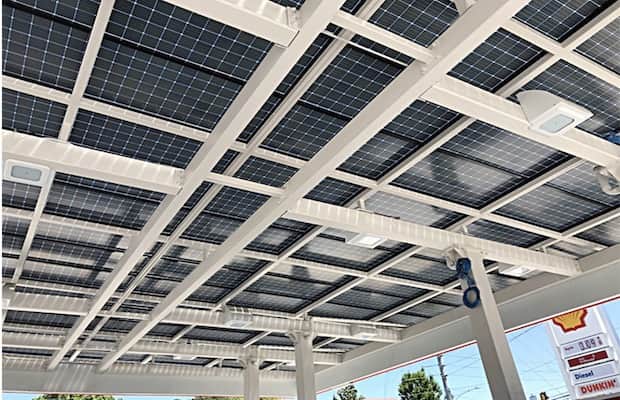

Double-sided solar cells are already enabling panels to sit vertically on land or rooftops and even horizontally as the canopy of a gas station, but it hasn’t been known exactly how much electricity these panels could ultimately generate or the money they could save. But now, a new thermodynamic formula reveals that the bifacial cells making up double-sided panels generate on average 15 percent to 20 percent more sunlight to electricity than the monofacial cells of today’s one-sided solar panels, taking into consideration different terrain such as grass, sand, concrete and dirt.
The formula, developed by two Purdue University physicists, can be used for calculating in minutes the most electricity that bifacial solar cells could generate in a variety of environments, as defined by a thermodynamic limit.
“The formula involves just a simple triangle, but distilling the extremely complicated physics problem to this elegantly simple formulation required years of modeling and research. This triangle will help companies make better decisions on investments in next-generation solar cells and figure out how to design them to be more efficient,” said Muhammad “Ashraf” Alam, Purdue’s Jai N. Gupta Professor of Electrical and Computer Engineering.
In a paper published in the Proceedings of the National Academy of Sciences, Alam and co-author Ryyan Khan, now an assistant professor at East West University in Bangladesh, also show how the formula can be used to calculate the thermodynamic limits of all solar cells developed in the last 50 years. These results can be generalised to technology likely to be developed over the next 20 to 30 years.
The hope is that these calculations would help solar farms to take full advantage of bifacial cells earlier in their use. “It took almost 50 years for monofacial cells to show up in the field in a cost-effective way,” Alam said. “The technology has been remarkably successful, but we know now that we can’t significantly increase their efficiency anymore or reduce the cost. Our formula will guide and accelerate the development of bifacial technology on a faster time scale.”
Alam’s approach is called the “Shockley-Queisser triangle,” since it builds upon predictions made by researchers William Shockley and Hans-Joachim Queisser on the maximum theoretical efficiency of a monofacial solar cell. This maximum point, or the thermodynamic limit, can be identified on a downward sloping line graph that forms a triangle shape.
The formula shows that the efficiency gain of bifacial solar cells increases with light reflected from a surface. Significantly more power would be converted from light reflected off of concrete, for example, compared to a surface with vegetation.
The researchers use the formula to recommend better bifacial designs for panels on farmland and the windows of buildings in densely populated cities. Transparent, double-sided panels allow solar power to be generated on farmland without casting shadows that would block crop production. Meanwhile, creating bifacial windows for buildings would help cities to use more renewable energy.
The paper also recommends ways to maximise the potential of bifacial cells by manipulating the number of boundaries between semiconductor materials, called junctions, that facilitate the flow of electricity. Bifacial cells with single junctions provide the largest efficiency gain relative to monofacial cells.
Source: Saurenergy.com
1. The mandate for blending Compressed Biogas (CBG) with natural gas has come into effect…
Andhra Pradesh is striving towards greening its energy sector with quite some speed. In a…
With an objective to bolster India’s green energy goals, a Tripartite Agreement has been signed…
The Union MNRE Minister Pralhad Joshi launched the Green Hydrogen Certification Scheme of India (GHCI)…
India’s energy conglomerate Bharat Petroleum Corporation Limited (BPCL) has commissioned a 5MW green hydrogen plant…
In a historical development, the European Space Agency (ESA) has successfully launched its pioneering ‘Biomass’…